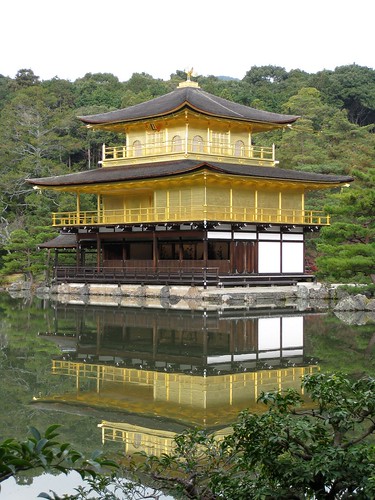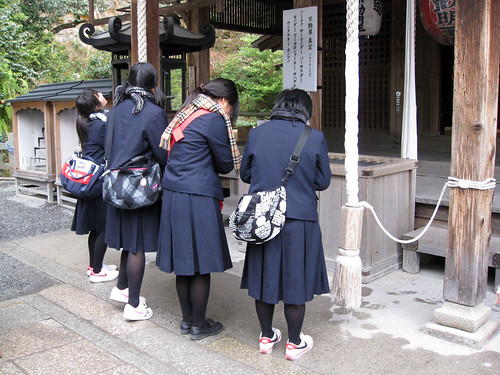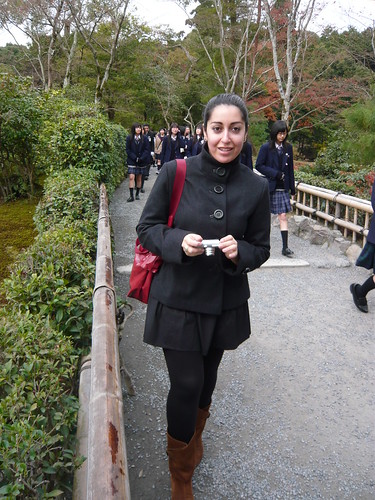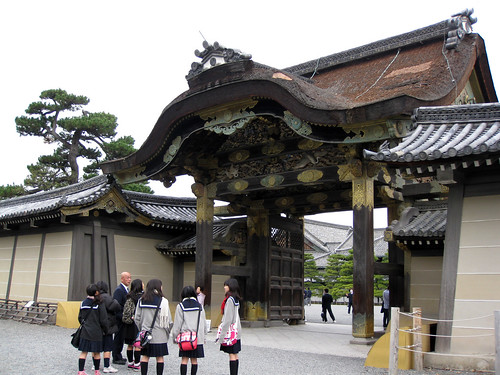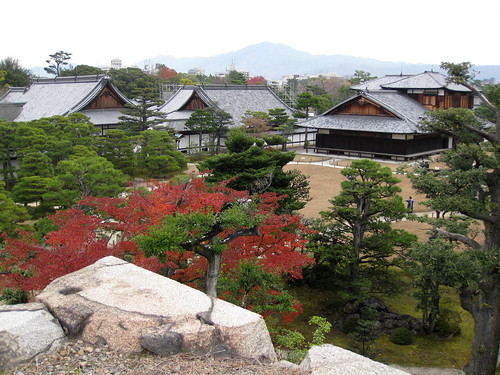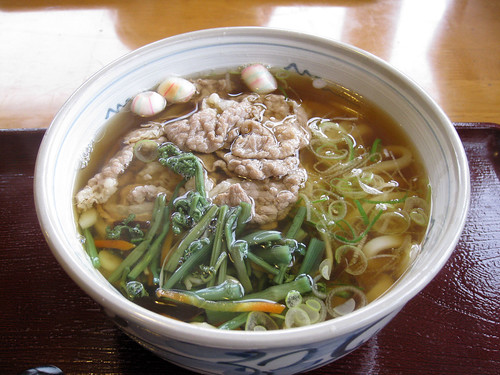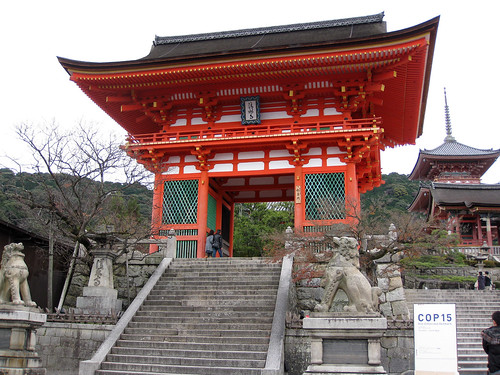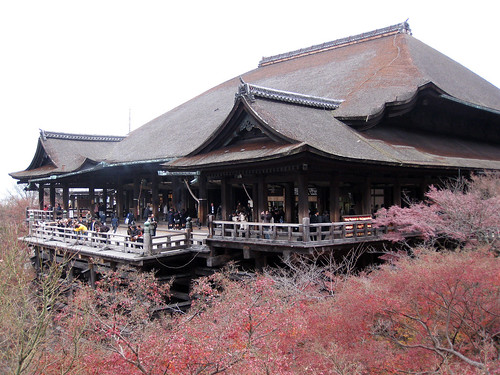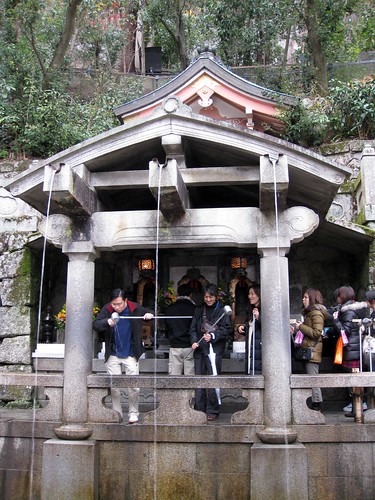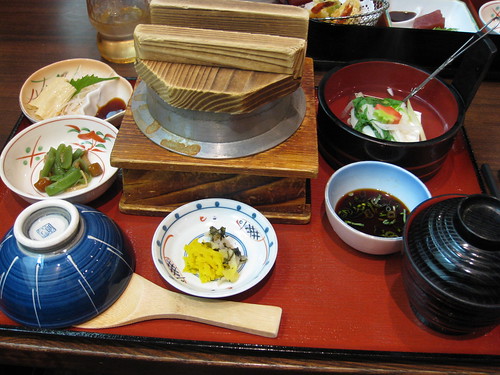On our last full day in Japan, Melody and I got up early and headed to Kyoto Station, where we arrived at the main bus terminal. Bound for Kinkaku-ji, we spent half an hour on a crowded bus full of what seemed like the entirety of Kyoto’s public school system on a field trip. If nothing else, the fifty or so children disembarking the bus at Kinkaku-ji served as a sign that we were headed in the right direction in a city where signs in English are at a minimum.
Kinkaku-ji, or the Temple of the Golden Pavillion, is easily one of Japan’s most striking sights, and it’s easy to see why.
A Zen Buddhist temple originally built in 1397, it was burnt down twice during the Onin War in the late 1400s and yet again by a monk in 1950. The pavilion was finally rebuilt in 1955.
Adjacent to a beautiful, mirror-like pond and a strolling garden, the pavilion is a three-story building within the grounds of the Rokuon-ji temple complex. The top two stories of the pavilion are covered with pure gold leaf and the structure houses relics of the Buddha inside.
After Kinkaku-ji, it was time for Nijo Castle, which was only a fifteen minute bus ride away. Built in the 1600s, Nijo Castle is essentially two concentric rings of fortifications (each consisting of a wall and a moat), the Ninomaru Palace, the ruins of the Honmaru Palace, a number of support buildings and several gardens throughout the grounds.
It started to rain as we were finishing exploring the castle grounds, so Melody and I rushed to catch the bus to our next destination: Kiyomizu-dera. The bus dropped us off at the foot of Sannen-zaka, a long and steep street that led to our destination. The walk up the hill was dotted with shops selling crafts and treats unique to Kyoto, as well as a number of inviting restaurants. We were hungry after our long walk, so we stopped at Seihan-Tei along the way to grab lunch.
Seihan-Tei specializes in hot soba and udon soups, and offers an expansive view of the city that we admired while we waited for our food to arrive. I had the udon with beef and wild mountain greens.
The beef left something to be desired but the hot broth was invigorating and the mountain greens were flavorful and crunchy. I wish I knew what they were so I could attempt to recreate this dish at home.
After lunch, we continued our walk up Sannen-zaka and soon arrived at Kiyomizu-dera.
A UNESCO World Heritage site, Kiyomizu-dera is a Buddhist temple that originated in 798, though its present buildings were built in 1633. Amazingly, not one nail was used in building the temple. The main hall is supported by tall pillars, and juts out over the hillside and offers incredible views of Kyoto.
During the Edo period, tradition held that if one were to survive the thirteen meter jump from the veranda, one’s wish would be granted. 234 jumps were recorded in the Edo period and, of those, over eighty-five percent survived. The practice is now prohibited.
The temple complex includes several other shrines, as well as the Otowa waterfall, where three streams of water fall into a pond. Visitors catch and drink the waters, which are believed to have therapeutic properties and provides wisdom, health, and longevity.
By the time we finished exploring Kiyomizu-dera, it was getting late, and we headed back to Kyoto Station. We found a restaurant serving incredible Kyoto-style cuisine at the station, though I’ve since forgotten the name of the restaurant. I had a meal set consisting of yuba (tofu skin), steamed rice with seafood and vegetables, hiyayakko (cold tofu), red miso soup and tsukemono (pickles).
I love meals like this because you get to try a little bit of everything. I’m a sucker for good pickles, so naturally, that was my favorite, along with the tofu skin.
Afterwards, it was time to return to our hotel and pack our bags. Our next morning would be a super early one, as we had to catch the shinkansen train back to Tokyo at five in the morning, and connect to the Narita Express train in Tokyo to take us to the airport. Bento boxes in tow, we groggily awoke the next morning and dozed for most of the three hour ride back as it poured rain outside.
We had a couple of hours to spare at Narita Airport, which we spent window shopping and picking up a few last minute wagashi, or traditional Japanese confectionery, as gifts. By the time we arrived in San Francisco the next day, we hadn’t had a proper rest for over 48 hours. I went straight to bed and caught up on sleep.
Since I’ve returned, I’ve been cooking a lot of Japanese food, eager to recreate the tastes and smells of my travels. Until I go back, my homemade agedashi tofus and onigiris and kitsune sobas will have to suffice.

